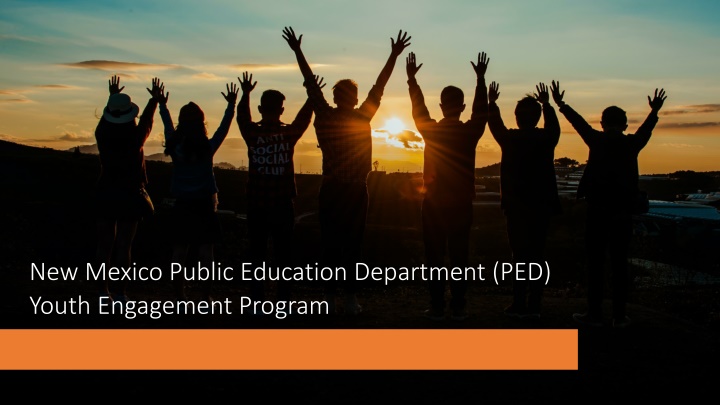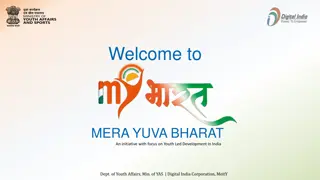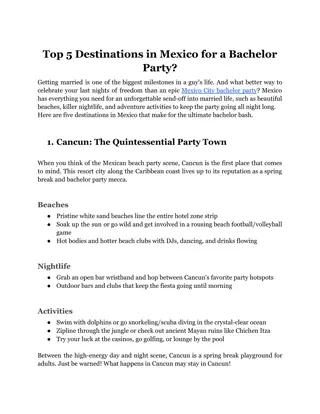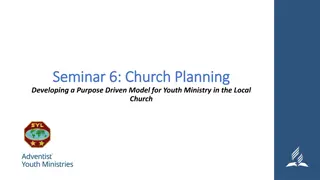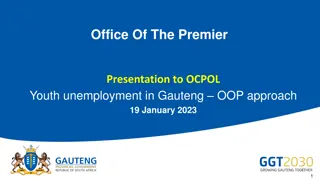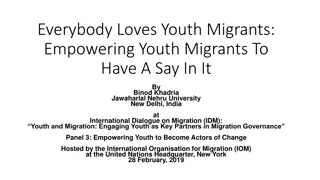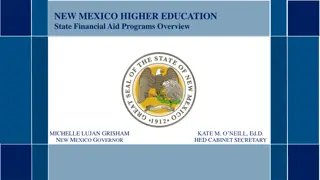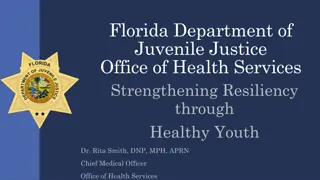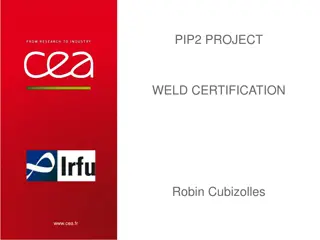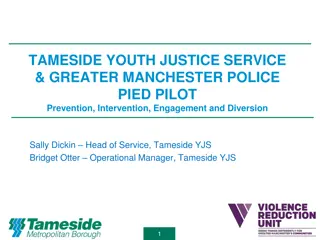New Mexico Public Education Department (PED) Youth Engagement Program
Meaningful youth engagement is an inclusive partnership between youth and adults where their contributions are valued, integrating young people's ideas, priorities, and perspectives into impactful programs and policies. The program empowers young people to be change agents in education and legislation, addressing community needs and challenges.
Download Presentation

Please find below an Image/Link to download the presentation.
The content on the website is provided AS IS for your information and personal use only. It may not be sold, licensed, or shared on other websites without obtaining consent from the author.If you encounter any issues during the download, it is possible that the publisher has removed the file from their server.
You are allowed to download the files provided on this website for personal or commercial use, subject to the condition that they are used lawfully. All files are the property of their respective owners.
The content on the website is provided AS IS for your information and personal use only. It may not be sold, licensed, or shared on other websites without obtaining consent from the author.
E N D
Presentation Transcript
New Mexico Public Education Department (PED) Youth Engagement Program
A Shared Philosophical Understanding Meaningful youth engagement is an inclusive, intentional, mutually respectful partnership between youth and adults whereby, respective contributions are valued, and young people's ideas, priorities, needs, perspectives, skills, and strengths are integrated into the design and delivery of meaningful programs, strategies, policies, and funding mechanisms that directly impact them and their communities. With impetus from (www.youthpower.org)
Mission The youth engagement program seeks to empower young people, create meaningful partnerships, and encourage their unique perspectives to be heard as they become valued change agents in the education, legislation, initiatives, systems, and programs that impact their lives and their communities.
Youth Engagement Program Goals To empower young people across the state of New Mexico to help facilitate the relevant changes that need to be made in our educational system to better address the needs of its communities To generate important dialogue by young people and is then shared with the power brokers around the state To create a meaningful partnership between state agencies and the communities they serve To move to the forefront the real challenges/issues that the state s young people encounter daily To give voice to those who are often marginalized within the state s educational and legislative systems To contribute to the understanding of the real legislation, initiatives and programs that would benefit New Mexican communities
What are the benefits of the Youth Engagement Program? Young people benefit by gaining skills, knowledge, self-esteem, and connectedness. Adults benefit by enhancing their own competencies, learning to better understand and value youth, and increasing their commitment and energy to their organizations. Organizations benefit by improving their programs, gaining community recognition, and attracting funders. Communities benefit by improving quality of life, coordinating youth services, and authentically embracing diversity by representing young people. https://actforyouth.net/youth_development/engagement/ State Agencies benefit by understanding and moving forward relevant and appropriate legislation that directly addresses the needs of its young people and its communities
Mark Kolokoff PED Youth and Community Liaison Mark is a Chicago native and has been teaching for over three decades. He holds a BA in Theatre, a dance minor, and an MA in Theatre Education from the University of Northern Colorado (UNC). Mark has directed over 75 theatre production ranging from straight plays to musicals and loves the creative process! He was Colorado s High School Theatre Teacher of the Year in 2009, given the Educator s Award by UNC s Graduate Program in 2012 and inducted into the Colorado State Thespian Hall of Fame in 2013. As the new Youth and Community Liaison, Mark is very excited to continue his work with the young people of New Mexico and help facilitate having their voices impact their education and access to opportunities. Mark has been married to Jeannette for 39 years and has two children, Briana, and Weston. He also enjoys playing Pickle Ball, cultivating roses, working with dogs (especially his poodle, Roxie) and of course, theatre.
Youth and Community Liaison Job Responsibilities The Youth and Community Liaison will: Manage: the Secretary s Student Advisory Council legislative engagement opportunities student networking creation of resources, toolkits, and communication artifacts local and statewide events
Facilitate: the SAC monthly and quarterly meetings youth engagement events and youth summit schools in developing positive home-school relationships with families communications with stakeholders the creation of youth engagement programs the building of statewide coalitions on key issues, supporting civic and legislative engagement serving and including youth engagement stakeholders- o parents and families o community-based organizations o state-wide partnerships o schools and educators o legislative leaders o State-wide New Mexico communities o divisions within the agency o other youth groups
Engage: in meaningful communication and feedback regarding key initiatives in collaboration with youth and community organizations and divisions in the promotion of engagement opportunities to target audiences in consultation and advisement to the executive leadership team regarding youth issues and priorities in support for the agency s strategic outcome efforts/plans
Youth Issues (partial list) Depression/Mental Health Violence in Schools Stress Academic Pressures Sexual Activity Peer Pressure Identity The New Normal Drug/Alcohol Abuse Poverty Vision and Framework E=engagement/G=goal) PED Youth Engagement Structure Education Inequality/Equity Bullying Academic Problems/Success Social Media Racism Growing Up Too Fast Indigenous people s Issues Time Management Participate in the dialogue (E) Establishing a shared language (E) Alignment to strategic priorities (G) Welcoming all families (G) Communicating effectively (E) Supporting student success (G) Speaking up for every child (G) Sharing leadership (E) Business Community Families Collaborating with communities (E Responsive Transformative Leadership/ Voice Student Centered Training PED Youth and Community Student Advisory Council PED PED YOUTH New Mexico s Youth Innovative YOUTH Communities/ Adults Vision and Framework Core Values Liaison VOICE VOICE Reflective Collaborative Change Agent Advocacy YOUTH VOICE Laws Practices Civic State Agencies/ Legislation Organizations NM Youth Organizations Policies & Initiatives Programs
Share/Listen Communication Process Adults/ Youth Organizations Families Validate Reflect Youth Voice S.A.C. Civic Leaders Schools PED Act Reflect
Student Advisory Committee members duties Attend all monthly and quarterly virtual meetings with PED liaison Compile and prioritize youth issues Act as liaison for one of the five regions (this will be done in teams of 2or 3) Attend virtual regional meetings to discuss relevant issues (Fall/Winter, 2021-22) Take part in Inspire 2022 student panel Plan for break-out session during Secretary s Community Advisory Conference Or Attend Youth Summit 2022, if offered Or Plan on implementing pilot School-Based Peer2Peer Support Program
Alignment with PEDs Strategic Plan Youth Support, Possible Actions/Programs
New Mexicos Public Education Departments Strategic Plan includes the following language related to social-emotional learning (SEL) Ensure that every school provides consistent opportunities for students to cultivate, practice, and reflect social and emotional competencies (self- awareness, self-management, social awareness, relationship skills, and responsible decision-making) A whole child and culturally responsive education includes the development and integration of social and emotional learning (SEL) into academic learning. Social-emotional skills (e.g., self-regulation, collaboration, problem-solving, conflict resolution, perseverance, resilience) are also essential in 21stcentury Culturally responsive SEL also provides a means for building skills for critical examination of existing biases and inequities and promotes more equitable outcomes A growing body of research in the learning sciences demonstrates that all children learn when they feel safe and supported. Each child, regardless of background, needs both supportive environments and well-developed abilities to manage stress and conflict Another review of 327 school climate studies found that support for student psychological needs and academic accomplishment is reflected in higher grades, higher test scores, and increased motivation to learn and is associated with strong interpersonal relationships, communication, cohesiveness, and belongingness between students and teachers Effective practices implemented as a result of the social and emotional learning framework indicates that students gain increased social and emotional learning competencies, including self-awareness, self- management, social-awareness, relationship skills, and responsible decision-making
Suicide is the second-leading cause of death among people aged 15 to 24 in the U.S. Nearly 20% of high school students report serious thoughts of suicide and 9% have made an attempt to take their lives, according to the National Alliance on Mental Illness. In February, a Pew survey found that 70 percent of teens say anxiety and depression is a "major problem" among their peers
According to statistics from the New Mexico Department of Health website, New Mexico has the second-highest rate of suicide in the nation, with a rate that is consistently 50% higher than the national average. Suicide is the eighth leading cause of death in our state for all ages but is the leading cause of death in 15- to 17-year-olds (this rate also includes unintentional injuries). It is the second- highest cause of death in age ranges from 5 to 14 and 18 to 35.
The following notes reflect the discussion that took place on May 1, 2022, between NMPED s Student Advisory Council and Mark Kolokoff, NMPED s Youth and Community Liaison, regarding the mental health issues that are dramatically impacting students in New Mexico and the nation. This topic was generated by the students. Please activate the link below to access the narrative of this discussion. Student Advisory Council Discussion notes-Mental Health
WHAT ARE SCHOOL-BASED PEER2PEER SUPPORT GROUPS? School-Based Peer2Peer Support groups - - are groups of Students who gather to share common concerns or personal issues and experiences associated with a particular problem, condition, illness, or personal circumstance. In a support group, students can talk with other students who are like themselves young people who can truly identify with what others are going through and can share the type of practical insights that can only come from firsthand experience. Some of the common characteristics of support groups include: Students who are all directly affected by a particular issue, illness, or circumstance and need help A licensed professional in attendance for every meeting Small sizes, to better allow all students to be heard and share A commitment to attend the meeting on a regular basis Peer leaders that are trained to facilitate and lead the group discussions Meetings that take place at a prescribed time, weekly, during the school day Resources for services that students may seek for further help
The Rationale Peer2Peer support programs can be defined as peer-to-peer interaction in which individuals who are of approximately the same age take on a helping role, assisting students who may share related values, experiences and lifestyles. Peer2Peer support programs can enhance the effectiveness of school counseling programs by increasing outreach and raising student awareness of services. Through proper selection, training and supervision, peer support can be a positive influence within the school and community. Research indicates peer support programs are helpful when focused on assisting students with social/emotional or academic problems, who are often marginalized and those with disabilities.Peer support programs can also help create a positive school culture and connectedness to the school community for all involved
The issues may be discussed in the School-Based Peer2Peer Support Groupsinclude, but are not limited to: Depression/Mental Health Violence in Schools Stress Education Inequality Academic Pressure Bullying Sexual Activity Academic Equality Peer Pressure Social Media Identity Issues Racism The New Normal Growing Up Too Fast Poverty People of Color Issues Drug/Alcohol Abuse Advocacy Suicide Social/Emotional Learning
Core Values Acceptance Respect Equity Dignity Engagement Relevance
